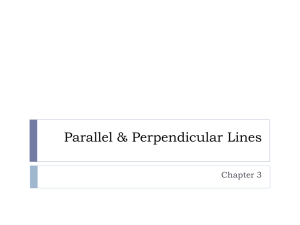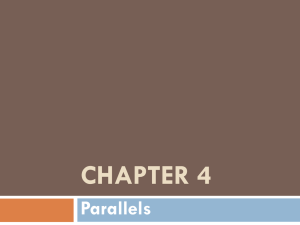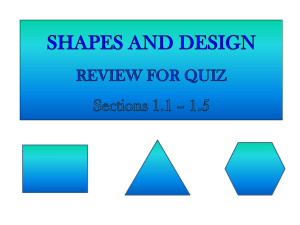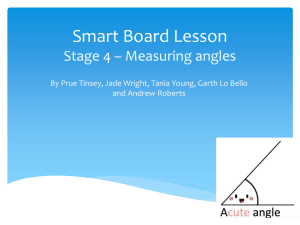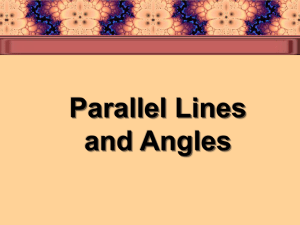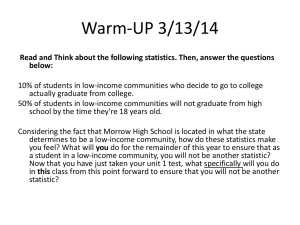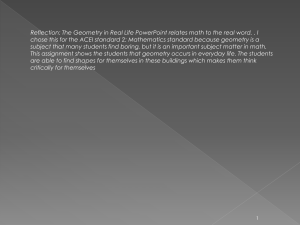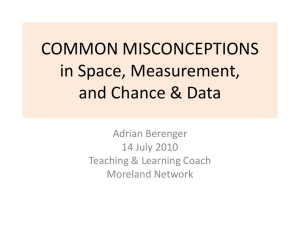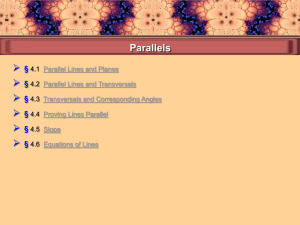Lines and Angles PowerPoint
advertisement
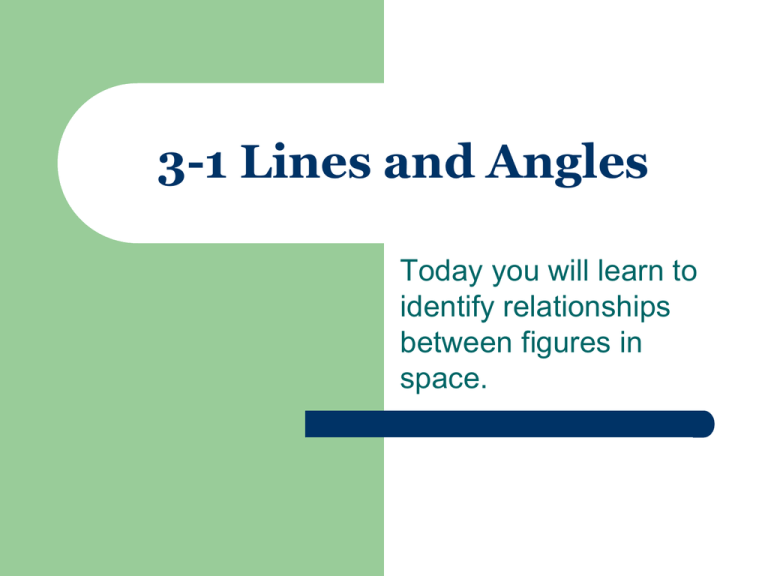
3-1 Lines and Angles Today you will learn to identify relationships between figures in space. What would you call two lines which do not intersect? Parallel B A D C A solid arrow placed on two lines of a diagram indicate the lines are parallel. The symbol || is used to indicate parallel lines. AB || CD A slash through the parallel symbol || indicates the lines are not parallel. B AB || CD A D C Skew Lines Two lines are skew if they are not in the same plane and do not intersect. AB does not intersect CD . A C B D Since the lines are not in the same plane, they are skew lines. Vocabulary Parallel lines are coplanar lines that do not intersect. Lines in different planes that do not intersect are skew. Parallel planes are planes that do not intersect. Perpendicular lines – lines that intersect and form right angles Identifying Types of Lines and Planes Identify each of the following. A. a pair of parallel segments LM ||QR B. a pair of skew segments KN and PQ C. a pair of perpendicular segments NS SP D. a pair of parallel planes plane NMR || plane KLQ Identify each of the following. a. a pair of parallel segments BF || EJ b. a pair of skew segments BF and DE are skew. c. a pair of perpendicular segments BF FJ d. a pair of parallel planes plane FJH || plane BCD Identifying relationships in space a. b. c. d. Think of each segment in the diagram. Which appear to fit the description? Parallel to AB and contains D Perpendicular to AB and contains D Skew to AB and contains D Name the plane(s) that contains D and appear to be parallel to plane ABE B C D A F E G H Parallel Postulate If there is a line and a point not on the line, then there is exactly one line through the point parallel to the given line. P l Perpendicular Postulate If there is a line and a point not on the line, then there is exactly one line through the given point perpendicular to the given line. P l Exit Ticket List the plane(s) parallel to plane CDE. Homework: WB p. 59 #1-15 3-1 Lines and Angles Today you will learn to identify angles formed by parallel lines and a transversal. Transversals If you have 2 coplanar lines that are intersected by a third (called a transversal), special angle pairs are formed. Transversal Interior Angles Angles between the two lines are interior angles. Exterior Angles Angles outside of the two lines are exterior angles. Same Side Angles Angles on the same side of the transversal are same side angles. Alternate Angles Angles on the opposite side of the transversal are alternate angles. Combined Angles The types of angles mentioned previously are only useful to us in certain combinations: – – – – Alternate interior Same side interior Alternate exterior Same side exterior (rarely used) Corresponding Angles If two angles occupy the same relative position at each of the points of intersection, they are corresponding angles. Which pairs of angles are corresponding? 1 2 3 4 5 6 7 8 Parallel Lines & Transversals Parallel lines are lines in the same plane that do not intersect. a a b When a transversal intersects parallel lines, the special angles pairs take on certain properties. b These arrows are how parallel lines are marked on a diagram. Parallel Lines Cut by a Transversal Get into pairs. On a sheet of paper, draw two parallel lines (either both horizontal or vertical). Now use your ruler to draw a transversal that intersects both parallel lines. 1 2 4 3 5 6 8 7 Label these pairs of angles: 1&5 4&6 2&8 Parallel Postulate (Remember, a postulate is something we accept as true without proof.) If parallel lines are intersected by a transversal, then the corresponding angles are congruent. In other words, if a ll b, then 1 2. a 1 2 b Parallel Lines & Transversal Parallel lines and transversals form special angles: Corresponding angles are congruent Alternate interior angles are congruent Same side interior angles are supplementary Alternate exterior angles are congruent A Special Case If there are a pair of parallel lines, and a transversal is perpendicular to one of them, then it is perpendicular to the other. If a ll b and a t, then b t. t a b Be Able to Name Special Pairs of Angles: 1. Alternate Interior Angles 2. Corresponding Angles 3. Alternate Exterior 4. Same-Side Interior Angles 2 1 3 4 6 5 7 8 Be Able to State the Relationship Between Any Two Angles: 1. Congruent Angles 2. Supplementary Angles Exit Ticket What three types of angles are congruent if lines are parallel and cut by a transversal? Homework – WB p. 60 (ALL)


